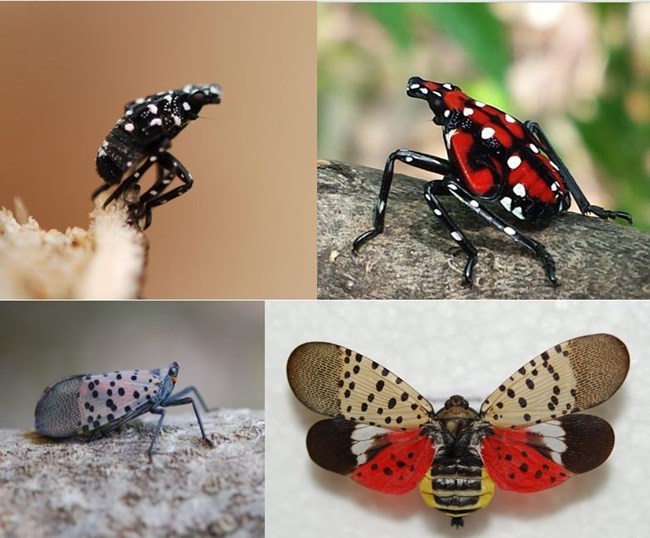Last updated: August 23, 2023
Article
Spotted Lanternfly

Top right corner: As the Lanternfly matures, it becomes red with black and white patches
Bottom row: Adult Spotted Lanternfly
NPS
What is the Spotted Lanternfly and where did it come from?The Spotted Lanternfly (Lycorma delicatula) (SLF), a member of the planthopper family, is an invasive insect that was first detected in the US (eastern PA) in 2014. SLF are native to Southeast Asia and feed on a wide range of plants and trees. Partially due to man-caused movement, SLF are spreading throughout much of the Mid Atlantic area including Virginia and have the potential to become a major threat to the region’s agriculture (ie. grapes, hops) and potentially it’s forest resources. As of this year, it’s been documented in all counties around the park and the park has had several sightings in the northern half of the park. SLF is well established throughout most of the Mid Atlantic area largely because it has no natural enemies. And currently, there are few effective chemical or biological controls that are available to combat this invasive pest. Why are we concerned?NPS policy states that we need to manage invasive species to reduce their impact on native species to the extent feasible (ie. hemlock woolly Adelgid). As of now, researchers have not verified that SLF kill trees or plants. However, SLF can weaken trees and plants and combined with other stressors (drought, other forest pests), they could contribute to tree mortality. BiologySLF is a planthopper that feeds on plant stems and sucks the nutrients from the tree and weakens it. The honey dew they produce often turns into sooty mold and can reduce a plant’s ability to photosynthesize (its ability to make food). SLF prefers to feed on Tree of Heaven or paradise tree. It also feeds on grape vine, apple, peach, hops, maple, poplar, walnut, willow, river birch, black cherry, sycamore, and tulip trees. How do I identify a Spotted Lanternfly?SLF live through the winter as eggs. Eggs are laid in masses on trees, under bark, on cars/RVs/trailers, on outdoor grills, and on many other surfaces. Newly laid egg masses have a gray mud-like covering which can take on a dry cracked appearance over time. Old egg masses appear as rows of 30-50 brownish seed-like deposits in 4-7 columns on the trunk, roughly an inch long. In late April and early May, young nymphs hatch. They are wingless and are black with bright white spots. As the nymphs mature they become bright red with distinct patches of black and white spots. Adults appear in July. The adult is a winged, flying leaf-hopper about 1 to 1 and ¼ inch long with grey wings with black spots. When the SLF opens its wings, you’ll see a bright red underwing with black wingtips. They are poor flyers but strong jumpers. Do Spotted Lanternflies kill trees and plants?SLF are relatively new to North America, and there is much that we don’t know. As of now, we have no knowledge that SLF kill trees and plants. However, SLF can weaken trees and plants. In Korea, SLF have had a major destructive impact on grapes and grape products such as wine. SLF have also reduced yields on important fruit-bearing trees (i.e. peaches). Because of the potential damage SLF could do to agricultural and forestry resources, they are considered an economic threat to our state and the region. Are Spotted Lanternflies dangerous to children and pets?SLF are not known to bite, sting, or attack people, pets, or livestock. It is not known if SLF are poisonous when ingested by humans or animals. Can I prevent Spotted Lanternflies from getting on my property?The best thing any property owner can do is to stay informed about SLF. Learn how to identify egg casings as well as all the life stages and monitor your property for signs of infestation. Remove or treat any Ailanthus trees (also called Tree of Heaven and considered a key tree host for SLF). In winter, scrape egg casings into a bag and dispose of them in the trash. Lastly, encourage natural predators by avoiding spraying pesticides. Information on treatment options can be found at https://www.pubs.ext.vt.edu/content/dam/pubs_ext_vt_edu/ENTO/ento-344/ENTO-344.pdf What is the park doing about Spotted Lanternflies?
What can you do to slow the spread of SLF?
Where can I get more information?Check out the following websites for additional information and management efforts: |
What Citizens Can Do (Includes an inspection checklist) https://www.vdacs.virginia.gov/pdf/spotted-lanternfly-checklist.pdf
USDA Spotted Lanternfly Link: https://www.aphis.usda.gov/aphis/resources/pests-diseases/hungry-pests/the-threat/spotted-lanternfly/spotted-lanternfly
Virginia Tech Spotted Lanternfly Resources: https://ext.vt.edu/agriculture/commercial-horticulture/spotted-lanternfly.html
Penn State Spotted Lanternfly Guide: https://extension.psu.edu/spotted-lanternfly-management-guide
